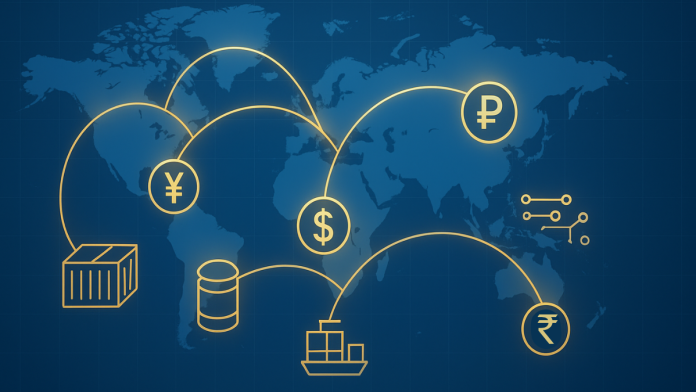The global economy is witnessing a major shift as three of the world’s biggest nations, India, China, and Russia, move closer together. What began as trade disputes and tariffs has now turned into a possible turning point for global commerce. With fresh talks of cooperation and upcoming high-level visits between the three countries, a new economic triad is quietly taking shape.
Analysts believe that the push from US trade tariffs, particularly under President Donald Trump, is playing a role in this alignment. While the United States continues to tighten trade policies, India, China, and Russia appear to be exploring ways to strengthen their economic ties and reduce reliance on Western markets and the US dollar.
Together, the three nations represent nearly one-third of the world’s economic output when measured in purchasing power parity. Their combined GDP (PPP) stands at $53.9 trillion, which is close to one-third of global production. This convergence is not just about trade numbers; it signals a shift in the global order from a single-power economy to a multipolar one.
Unity in Scale and Trade
India, China, and Russia bring together a population of more than 3.1 billion people. That is nearly 38% of the global population, making this grouping the largest consumer base in the world. This vast market gives the trio a powerful edge in global trade and investments.
India-China relations see cautious reset as US tariffs tensions escalate
In exports, the combined strength of these nations reaches $5.09 trillion, which is about one-fifth of all merchandise exports worldwide. Their reach extends across continents, linking industries, energy supplies, and technological flows.
The group also holds foreign reserves worth $4.7 trillion. This amounts to almost 38% of the world’s reserve holdings, creating a financial cushion that helps shield them from sudden economic shocks. With such strong reserves, they are less vulnerable to external pressures and can manage trade disruptions more effectively.
Shifting Away from the Dollar
Another factor bringing India, China, and Russia closer is their shared interest in reducing dependence on the US dollar in international trade. The global economy still relies heavily on the dollar for transactions, but this trio is exploring ways to conduct trade in their local currencies.
This trend gained pace after Western sanctions on Russia. In response, Russia began selling crude oil to India and China in local currencies. This practice allowed both India and China to save more dollars in their reserves while continuing to secure energy supplies at lower costs.
Canada eases trade stance with U.S. as Carney confirms removal of several tariffs
Such currency adjustments also play a role in what experts call “de-dollarisation.” By reducing the dominance of the US dollar in trade, the three countries are building alternative channels that could change how global markets operate.
Defence, Energy, and Market Strengths
The partnership extends beyond trade and currency. The combined military spending of India, China, and Russia stands at $549 billion, which is over 20% of the world’s defence budget. This military strength gives them an additional layer of influence in global affairs.
In terms of energy, the trio consumes nearly 35% of the world’s total energy. Russia’s oil and gas reserves, China’s manufacturing capabilities, and India’s fast-growing service economy together create a wide-ranging balance of strengths.
India, which already has a long-standing partnership with Russia, is now in talks with China on expanding trade routes and investments. China, facing rising trade barriers in the United States and Europe, is also looking at India’s growing markets as an important outlet for its industries.
The idea of this trinity is not just about current trade figures. It is also about how these three nations are finding ways to support each other in times of global uncertainty. With Trump’s tariffs making exports harder and costlier, India, China, and Russia appear to be seeking new ground to continue their growth.


